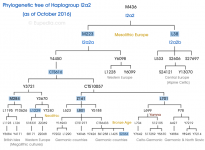eupator
destroyer of delusions
- Messages
- 507
- Reaction score
- 281
- Points
- 63
- Ethnic group
- Rhōmaiōs (Rumelia + Anatolia)
Goodness knows what Herodotus meant by Persians, though. Persians as in straight from Persia, or Persians as in people in the Persian Empire, which would have included Anatolians?
Ethnography was not exactly his forte, as we have discovered in his writings about the Etruscans.
Also, the spread was pretty extreme, from ten or less to a few with 20%, and the Caucasus/Iran Neo in Iranians looks like 80% in some of them, so I guess it depends on what you mean by kinship.
Kinship as in there were blood relations between them.
20% top end means it's almost 1/4 grandparent. It's quite significant, evident also in the J uniparentals (and G for the Caucasus).
Anatolia stands in between the Iranian Plateau/Caucasus and the Aegean coastline in Greece, there is a gradient that is visible in autosomals.
The Pelasgian substratum is of Anatolian (major) + Irano-Caucasian (minor) extraction, then you add the EHG signal from the north, Herodotus is being vindicated almost to a tee in what he wrote about his contemporaries in Greece.




